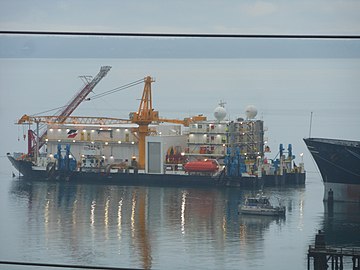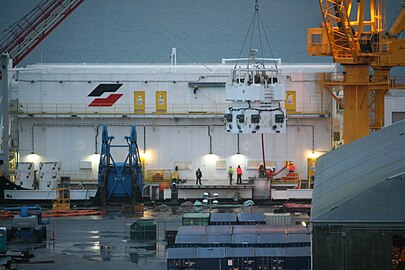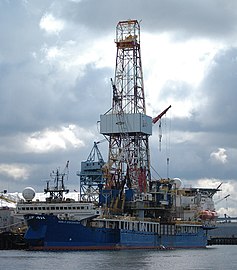Seattle Arctic drilling protests
| Seattle Arctic drilling protests | |
|---|---|
| Part of Petroleum exploration in the Arctic | |
 | |
| Location | |
Protests against Arctic drilling began in
On September 27, 2015, Shell announced that their exploration in the summer of 2015 was "disappointing" and that they would abandon further oil exploration in the Arctic "for the foreseeable future".[5]
Historical background
"All science points to the fact that oil is an archaic technology at this point. It's not a sustainable technology to further invest in."
Kayaktivist Dana Schuerholz,
"For Seattle to remain a thriving and viable maritime city, it cannot continue to set a hostile tone and environment toward our port and maritime sector."
Joshua Berger of the Washington Maritime Federation.[6]



Seattle has been a staging point for those seeking to exploit the
The city of Seattle says the maritime sector which includes ship builders, cargo vessels and tug companies comprises 22,000 jobs for a $2.1 billion annual contribution to the Seattle economy.[6]
Seattle is known for
In the summer 2012, Shell refurbished the
The Kulluk ran aground in January 2013 and had to be rescued, resulting in the US Department of the Interior ordering Shell to halt drilling until safety problems were corrected.[10] Shell was criticized in an Interior Department report, which cited inadequate supervision of subcontractors by Shell's management, and a lack of preparedness for the Arctic conditions.[10] New regulations were written by the department, and drilling was restricted to shallower waters, up to 140 ft (43 m) deep, and to summer months only, and stricter rules on blowout preventers were put in place.[10]
Environmentalists and oil industry experts agree the area is one of the most dangerous areas in the world to drill, because besides rough seas including 50 ft (15 m) waves, storms, and cold weather, the cleanup and rescue is made harder by a lack of any roads to major cities and no
Shell's Alaska vice president Pete Slaiby said its goal was not, "any kind of grand energy independence", but rather that, "This is all about energy choice," so that the US could replace oil imports from hostile foreign regimes with domestic production.
Prior to public discussion
In October 2013, Terminal 5's tenant, Eagle Maritime Services, made plans to relocate. The Port of Seattle decided to update T5, and they asked businesses, including
The purpose of the new lease was to provide an off-season harbor for Shell vessels conducting exploratory drilling in the summer in the Chukchi Sea off Alaska's northwest coast.[6] The US Geological Survey has estimated the offshore reserves in the Arctic at 26 million barrels of oil and 130 trillion cubic feet of natural gas.[6]
The leases of Eagle Marine Services and Westwood Shipping Lines ended in July 2014, so the following month Eagle moved to the Port of Seattle's Terminal 18 and Westwood moved to
Public announcement and protest

On January 13, 2015, the first public meeting North Slope fleet at Terminal 5.[1] On February 9, the lease with Shell was signed by Port of Seattle CEO Ted Fick.[1]
When the deal became known, Seattle Mayor Ed Murray and the Seattle City Council announced they would review it.[12] On March 9, the city of Seattle began looking for ways it could hinder the deal.[1] Murray asked Port to reconsider the contract with Foss, and said that the Port of Seattle must get permits for new uses in order to host the Arctic drilling fleet, explaining that, "This is an opportunity for the port and all of us to make a bold statement about how oil companies contribute to climate change, oil spills and other environmental disasters – and reject this short-term lease."[6]

Shell's Polar Pioneer semi-submersible drilling rig arrived in Port Angeles, Washington on April 17, 2015, on its way to Seattle.[1] The Polar Pioneer, IMO number: 8754140, was built in 1985 by Hitachi Zosen Corporation in Ariake, Kagoshima, Japan.[13] The rig is 400 ft (122 m) long and 292 ft (89 m) wide, with a draft of 30 ft (9.2 m), and rising to a height of 307 ft (94 m), measuring 38,564-gross tonnage (GT).[1][13] It is driven by electric motors powered by diesel generators, at an average speed of 6.3 knots (11.7 km/h; 7.2 mph) , and a maximum of 8.2 knots (15.2 km/h; 9.4 mph).[13][14] The Marshall Islands-registered ship is owned and operated by Transocean, and is ander contract to Royal Dutch Shell.[13]
On May 11, the Obama administration and the Department of the Interior announced that Shell had won conditional approval to being exploratory drilling in the Chukchi Sea with leases Shell had acquired in 2008.[10] Seven more state and Federal permits would be required to commence operations.[4] The decision was a victory for Shell, having worked for several years to overcome regulatory roadblocks, based primarily on concerns of an accident like the 2010 Deepwater Horizon oil spill in the Gulf of Mexico.[10] The dangers of the Arctic seas and weather were seen as increasing the risk of an accident, as well as exacerbating the difficulty of containing a blowout and oil spill, and carrying out cleanup.[10] An earlier attempt to begin drilling was suspended due to safety issues including a fire on one rig.[4]
On May 12, the same day Port Commissioners filed an appeal of the city's land use permit decision, Shell's drillship Noble Discoverer arrived in Everett, Washington on its way to Bellingham, Washington.[1][15] The ship, IMO number: 6608608 is a Liberian-flagged Sonat Discoverer-class drillship built in 1966 by Namura Shipbuilding and owned by Noble Corporation, weighing 16,000-gross tonnage (GT), 514 ft (157 m) long with a 175 ft (53 m) tall drilling derrick capable of drilling in 1,000 ft (300 m) of water to a drilling depth of 20,000 ft (6,100 m).[16][17] It was met by 10 protesters in kayaks, along with a Greenpeace motorboat carrying reporters.[15] The kayakers displayed banners reading "ShellNo.org" and "Arctic drilling = climate chaos".[15] The Everett protest was described by one kayaktivist as "just a warm up" for the upcoming event in Seattle.[15]
In the pre-dawn hours of May 14, the Polar Pioneer left Port Angeles with a Coast Guard and tugboat escort.[1] A 500-foot (150 m) safety zone was established around the moving rig, and the Coast Guard issued warnings to protesters ahead of time to stay clear.[1] At least 20 kayaks, and members of the Duwamish Tribe in a large wooden canoe, greeted the rig in Elliott Bay, unfurling a banner reading "Arctic Drilling = Climate Change."[1] Many of the kayakers were freshly trained that day, in rented boats.[1] When the Polar Pioneer arrived in Elliott Bay, it was met by a flotilla of hundreds more protesters in kayaks and other small boats, voicing their opposition to oil drilling in Arctic waters because of the risk of oil spills, undersea oil well blowouts, damage to wildlife from human activity, and the climate change caused by the use of fossil fuels.[4][10] There were no problems or arrests during the protest and the Polar Pioneer was safely moored at Terminal 5 at 4:30 pm.[1]
"We think that if they're not in Seattle then it may be the end of Arctic drilling for the near future."
City Council member Mike O'Brien[12]
A counter-protester at Seacrest Park, recently laid off from the maritime industry, said "If these (activists) choose to put me and guys like me out of work for an idea, what are they trying to do?"[1] Foss Maritime said to date, 417 people had been employed by the Shell contract, with Shell paying Transocean $593,000 per day to lease the Polar Pioneer, out of some $6 billion the company was going to spend on Alaska oil exploration.[1] Over the life of the two-year lease, Foss will pay $13.17 million to the Port of Seattle.[1]
Democratic Alaska State Representative Bob Herron said on the Alaska State House floor, "It must be nice to eat cheese and sip wine in Olympia while they talk about the Arctic. But it does remind us of the paternalistic past when the state of Alaska was plundered by people from Washington and other areas ... who covet our resources."[7]
Shell said they were committed to drilling in the Arctic one way or another, but City Council member
As part of the ongoing series of protests, activists from the group Mosquito Fleet* rented a 4,000 sq ft (370 m2) barge from Lakeshore Marine Construction of Kenmore.[11] They anchored it off Seacrest Park, christening it "The People's Platform", and equipping it with speakers, video equipment, a huge video screen, and solar and wind power supplies.[11] The project was led by Arctic drilling protest organizer John Sellers, who works for a nonprofit called The Other 98% which addresses "undue corporate influence". The Mosquito Fleet raised $16,400 in donations in 6 days with a YouTube video proposal on Indiegogo to fund the barge rental, at a rate of about $15,000 every two weeks.[11]
On May 22, 2015, the protests spread to Bellingham when student activist Chiara D'Angelo chained herself to the anchor chain of the Royal Dutch Shell barge Arctic Challenger for 63 hours.[18]
*
Shell's arctic drilling fleet
-
The Shell Polar Pioneer in Norway in 2011
-
Polar Pioneer at Terminal 5 in 2015
-
The Arctic Challenger blowout containment vessel, in Bellingham in 2012
-
Arctic Challenger's containment dome
-
The Noble Discoverer drillship in Seattle in 2012
-
The Kulluk in Elliott Bay in 2012
-
The Kulluk after running aground in January 2013
See also
- Arctic policy of the United States
- Arctic Refuge drilling controversy
- Petroleum exploration in the Arctic
- Save the Arctic
Notes
- ^ Seattle Times, retrieved May 27, 2015
- ^ 'Paddle in Seattle' Arctic oil drilling protest, BBC News, May 17, 2015
- ^ a b Ryan, John (May 18, 2015), Hundreds Of 'Kayaktivists' In Seattle Protest Shell's Arctic Drilling, KUOW-FM, retrieved May 27, 2015
- ^ a b c d e f g h Usborne, David (May 17, 2015), "Seattle's 'kayaktavists' protest against plans by Royal Dutch Shell to drill for oil in the Arctic and warn of 'ecological catastrophe'", The Independent, retrieved May 27, 2015
- Seattle Times, retrieved September 28, 2015
- ^ TheFreeLibrary
- ^ Seattle Times, retrieved May 27, 2015
- ISBN 9780262262804
- ^ a b c d e Bernton, Hal (June 25, 2012), "Shell Refurbishing Rig for Drilling in Oil Fields off the Alaskan Coast", The Buffalo News, Buffalo, New York
- ^ New York Times, retrieved June 21, 2015
- ^ Seattle Times, retrieved May 28, 2015
- ^ Hayes, Chris (May 17, 2015), Seattle vs. Big Oil: Revolt over Shell deal; After Shell secures a two-year lease to make the Port of Seattle its base for arctic drilling, the city fights back., MSNBC, retrieved May 27, 2015. Interview with Seattle City Council member Mike O'Brien.)
{{citation}}: CS1 maint: postscript (link - ^ DNV GL, 2015
- ^ Polar Pioneer, Marine Traffic, 2015
- ^ Everett Herald, May 12, 2015, retrieved June 21, 2015
- ^ Noble Discoverer, Noble Corporation, 2015, archived from the original on 2013-01-01
- DNV GL, 2015
- Christian Science Monitor, May 25, 2015, retrieved May 29, 2015
References
- Bernton, Hal (May 18, 2015), "Demonstrators leave peacefully after protest against Shell oil rig", Seattle Times, retrieved May 27, 2015
External links
- Shell in the Arctic Royal Dutch Shell official website on Arctic drilling
- shellno
.org Coalition against Arctic drilling











